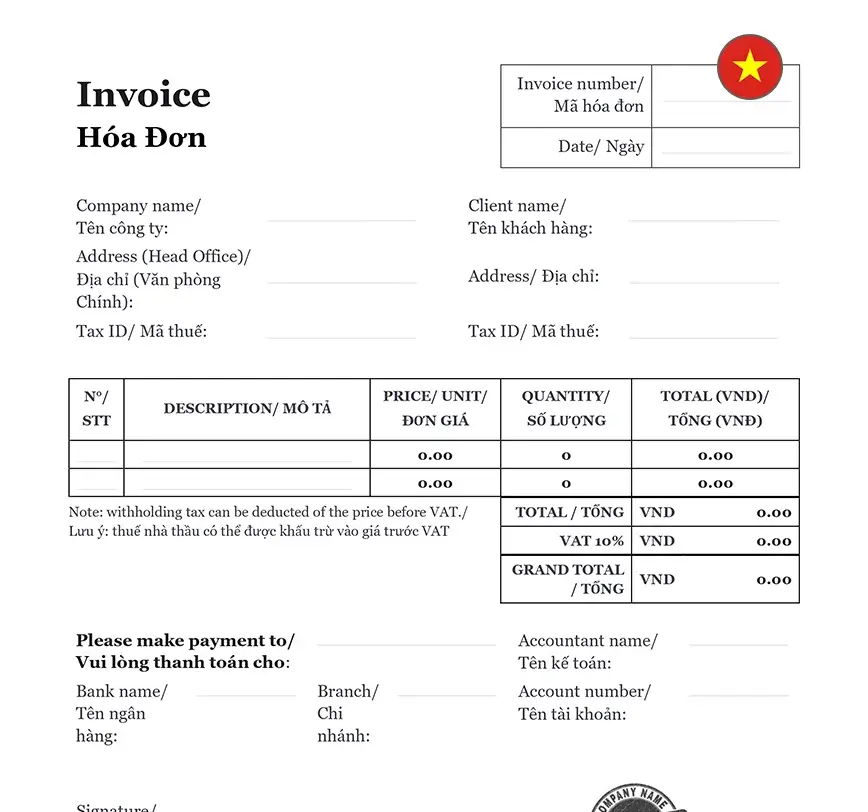Ready to use legal template
Work on without any hassle
Vietnamese-English translation
Ready to use legal template
Work on without any hassle
Vietnamese-English translation
Home › Accounting › Invoice
Learn more about Invoice in Vietnam
An Invoice is a formal document issued by a seller to a buyer, detailing the goods or services provided, their quantity, price, and payment terms. It serves as a critical record for both businesses and individuals, ensuring transparency in transactions and compliance with Vietnamese tax and accounting regulations. Proper invoicing helps businesses maintain accurate financial records, streamline payment processes, and meet regulatory requirements set by the General Department of Taxation. Whether you are a freelancer, small business, or corporation, having a well-structured invoice ensures smooth financial operations and professional credibility. Download our Invoice Form, easy to edit in Word format, professionally drafted in English and Vietnamese to ensure compliance with Vietnam’s accounting and tax regulations.
Table of contents
What is an Invoice?
What is included in an Invoice?
Why are invoices important for businesses in Vietnam?
What is the difference between an Invoice and a Receipt?
When to make an Invoice in Vietnam?
How to issue an Invoice in Vietnam?
Are there different types of invoices?
What is the VAT treatment for invoices in Vietnam?
What is an Invoice?
An invoice serves as a cornerstone in the realm of commerce, functioning as a formal documentation of a transaction between a seller and a buyer. It encapsulates crucial details such as the specifics of the products or services exchanged, the agreed-upon prices, quantities, and the terms of payment. This document not only facilitates the smooth flow of financial transactions but also acts as a legal instrument, providing evidence of the agreement reached between the involved parties. By meticulously outlining the terms of the sale, an invoice helps foster transparency and trust in business dealings while serving as a foundational element in accounting practices.
In the business landscape, invoices play a pivotal role in streamlining operations and ensuring financial stability. They serve as a fundamental tool for businesses to track revenue, manage cash flow, and uphold regulatory compliance. Moreover, invoices provide a mechanism for resolving disputes and clarifying any discrepancies that may arise during the course of a transaction. From small-scale enterprises to multinational corporations, the issuance and management of invoices are essential practices that underpin the financial health and integrity of businesses worldwide.
What is included in an Invoice?
An invoice typically includes a comprehensive array of details essential for documenting a transaction and facilitating payment. These elements commonly consist of:
Seller and Buyer Information: The names, addresses, and contact details of both the seller (the entity providing the goods or services) and the buyer (the recipient of the goods or services).
Invoice Number and Date: A unique identifier assigned to the invoice for tracking purposes, along with the date on which the invoice was issued.
Description of Goods or Services: A detailed breakdown of the products sold or services rendered, including item names, quantities, unit prices, and any applicable taxes or discounts.
Total Amount Due: The sum total of all items listed on the invoice, accounting for any taxes, discounts, or additional charges.
Payment Terms: The agreed-upon terms and conditions governing payment, such as the due date, acceptable payment methods, and any late payment penalties.
Payment Instructions: Instructions on how the buyer should remit payment, including details such as bank account information or payment gateway links.
Terms and Conditions: Any additional terms or conditions relevant to the transaction, such as return policies, warranty information, or dispute resolution procedures.
Seller’s Business Details: Information about the seller’s business, including their business name, registration number, tax identification number (if applicable), and any relevant legal disclaimers.
Buyer Reference: Optional reference fields for the buyer to include their own internal identifiers or purchase order numbers, if necessary.
Why are invoices important for businesses in Vietnam?
Invoices hold significant importance for businesses in Vietnam for several reasons:
| ➤ Legal Compliance: In Vietnam, maintaining accurate and legally compliant financial records is a legal requirement. Invoices serve as crucial documents for taxation purposes, helping businesses adhere to regulatory obligations and avoid penalties. |
| ➤ Evidence of Transactions: Invoices provide concrete evidence of transactions between businesses and their clients. They detail the terms of the sale, including the products or services provided, quantities, prices, and payment terms, thereby establishing a clear record of business dealings. |
| ➤ Financial Management: Invoices play a vital role in financial management by facilitating revenue tracking, cash flow management, and budgeting. They provide businesses with insights into their income streams, outstanding payments, and overall financial health. |
| ➤ Dispute Resolution: In the event of disputes or discrepancies, invoices serve as valuable documentation to resolve issues amicably. They provide a reference point for reconciling differences and clarifying the terms of the agreement between parties. |
| ➤ Credibility and Trust: Properly issued invoices enhance a business's credibility and foster trust with clients and partners. They demonstrate professionalism, transparency, and reliability in business transactions, contributing to long-term relationships and repeat business opportunities. |
| ➤ Tax Deductions and Rebates: Invoices facilitate the claiming of tax deductions and rebates for eligible business expenses. Properly documented invoices enable businesses to accurately report their income and claim legitimate tax deductions, thereby optimizing their tax obligations. |
| ➤ Audit Preparedness: Invoices serve as essential documentation during financial audits conducted by tax authorities or regulatory bodies. Maintaining comprehensive and organized invoicing records ensures businesses are well-prepared for audits, reducing the risk of compliance issues or financial penalties. |




